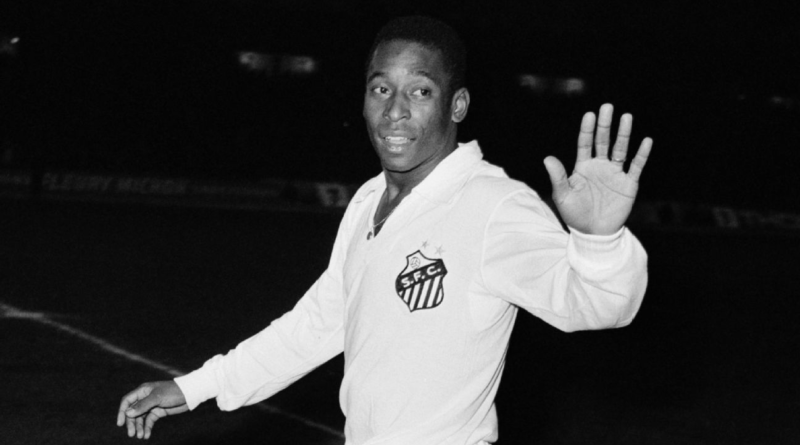'Genius, King, God': Brazil gave Pele many names, and he lived up to them all
In the 1970 World Cup, Pele’s strike partner was Tostao, one of the brightest players ever to represent Brazil.
They first lined up together in 1966, when Brazil began their preparation for that year’s World Cup close to Tostao’s hometown. He introduced his father to Pele — and was amazed to see his father break down in tears. “It was as if he was meeting his god,” Tostao, still astonished, told me many years later. So the idea of Pele being something like a religious icon is nothing new.
– Stream on ESPN+: LaLiga, Bundesliga, more (U.S.)
The entire front cover of Friday’s Estado de Sao Paulo newspaper was given over to a haunting, iconic, grainy photo of the man in the No. 10 jersey of Santos, accompanied by the headline “Pele has died, if Pele can die.”
Inside the paper, the theme continued: “Like the Gods of Olympus, Pele does not grow old or pass away. He will always be alive, marked in global memory as the Brazilian who used football to make humanity dream.”
His birth name was Edson Arantes do Nascimento. Pele himself had often made the point — Edson would die one day, but Pele was eternal. He appeared to live the division between man and myth as something entirely natural. His younger sister, Maria Lucia, gave details of their last conversation and said that her brother had gone in peace. “I’m Edson’s sister,” she said. “To be Pele’s sister is impossible to explain, because he was chosen by God to represent Pele on earth.”
It is an interesting spiritual perspective — that someone was given a mission to be Pele, and that someone ended up being a shoeshine boy from small-town Brazil who ended up shining more brightly than anyone else in the history of the game.
One of the first to spot the enormity of the Pele phenomenon was Nelson Rodrigues, a leading Brazilian playwright who was also perhaps the country’s most influential football writer. He saw the game as an epic psychodrama, and the character of Pele was perfect for his myth-making. As early as April 1959, when Pele was still only 18, Rodrigues was writing that Pele “belongs much more to the mythology of football than to the sport itself.”
At the end of 1958, the year in which Brazil won the World Cup for the first time, Rodrigues pondered that Pele “is undoubtedly a genius. I say it and repeat it — a genius, Pele can turn to Michelangelo, Homer or Dante and greet them with the effusive intimacy of ‘how are you, mate?’ Just as Michelangelo is the Pele of painting, of sculpture, Pele is the Michelangelo of the ball.”
Perhaps even more striking is a column from April 1958, before Brazil won the World Cup in Sweden that year, when Pele was still not especially famous in Rio de Janeiro, where Rodrigues was based. “Pele has a considerable advantage over other players,” he wrote. “That of feeling like a king, from his head to his toes. He has an entirely natural sensation of superiority.” Rodrigues was the first to award Pele the crown of royalty.
For Rodrigues, Brazil were already the best in the world, only continually to be let down by an excess of humility. In this, he saw Pele as the solution. “In Sweden he is not going to tremble in front of any opponent. He won’t feel inferior in front of anyone. It is this virile and even insolent attitude that we need. Yes, my friends, I bet my head that Pele will think all of our opponents are a bunch of wooden legs. With Pele in the team, and others like him, no one will go to Sweden with the soul of a mongrel. The others will tremble in front of us.”
– Andscape: Pele was the epitome of Black grace in soccer
And just a few months later, in magnificent style, with Pele scoring six wonderful goals in the final three games, Brazil brought the trophy back from Sweden.
Part of Pele’s gift, then, was to understand the enormity of his talent, and to feel totally comfortable with the responsibilities that came along with it. He wore the cloak of greatness as if it had been made to measure.
It explains why he was such a wonderful big-game player. Pele and his supporters surely made a mistake by placing so much emphasis on the number of goals that he scored over the course of his career. The man was about so much more than grim statistical accumulation, especially as the figure has been inflated by the inclusion of games he played for the Brazilian Army.
The soul of Pele is much better found on the big stage. It was why he loved the Maracana so much; the giant stadium was a suitable location for him to parade the enormity of his talent. The real Pele was in the key clashes in the World Cup, or the second leg of the 1962 Club World Cup — a big deal at the time — where he destroyed Benfica in Lisbon to win the title for Santos.
These are the occasions that will ensure that Pele is eternal.



